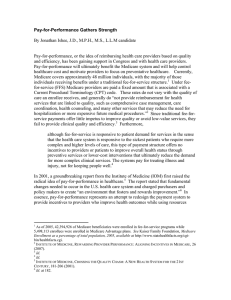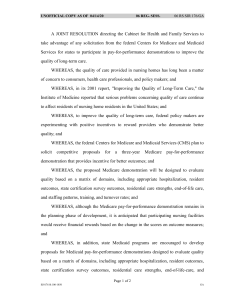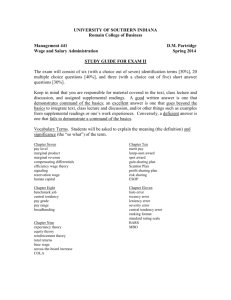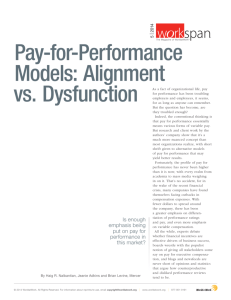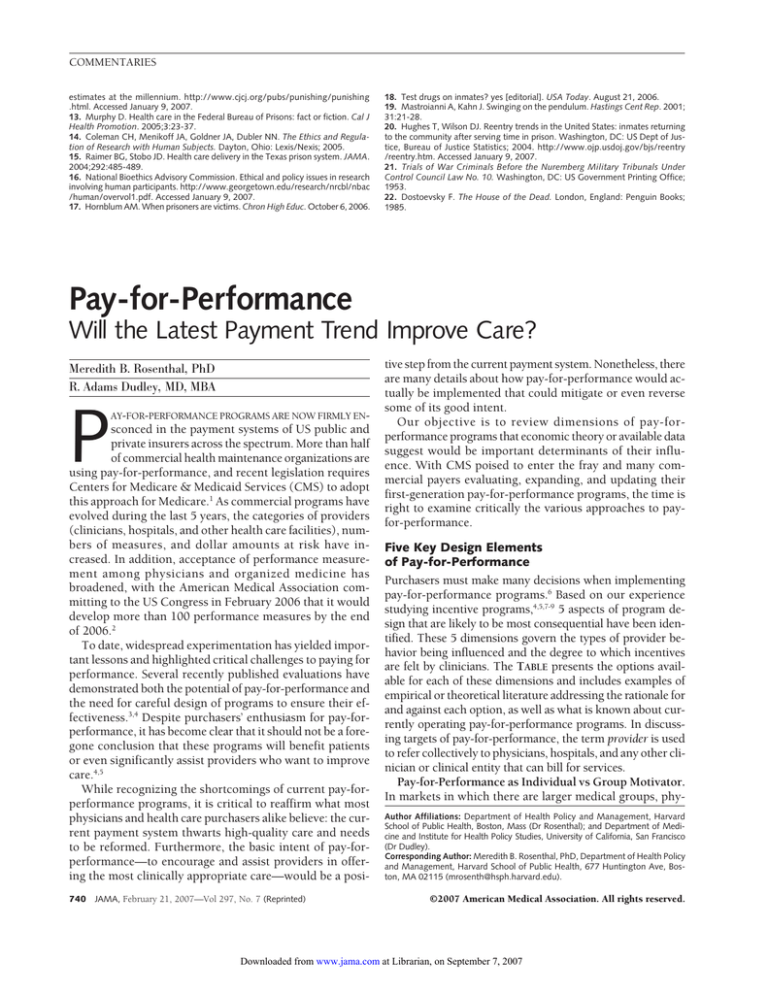
COMMENTARIES
estimates at the millennium. http://www.cjcj.org/pubs/punishing/punishing
.html. Accessed January 9, 2007.
13. Murphy D. Health care in the Federal Bureau of Prisons: fact or fiction. Cal J
Health Promotion. 2005;3:23-37.
14. Coleman CH, Menikoff JA, Goldner JA, Dubler NN. The Ethics and Regulation of Research with Human Subjects. Dayton, Ohio: Lexis/Nexis; 2005.
15. Raimer BG, Stobo JD. Health care delivery in the Texas prison system. JAMA.
2004;292:485-489.
16. National Bioethics Advisory Commission. Ethical and policy issues in research
involving human participants. http://www.georgetown.edu/research/nrcbl/nbac
/human/overvol1.pdf. Accessed January 9, 2007.
17. Hornblum AM. When prisoners are victims. Chron High Educ. October 6, 2006.
18. Test drugs on inmates? yes [editorial]. USA Today. August 21, 2006.
19. Mastroianni A, Kahn J. Swinging on the pendulum. Hastings Cent Rep. 2001;
31:21-28.
20. Hughes T, Wilson DJ. Reentry trends in the United States: inmates returning
to the community after serving time in prison. Washington, DC: US Dept of Justice, Bureau of Justice Statistics; 2004. http://www.ojp.usdoj.gov/bjs/reentry
/reentry.htm. Accessed January 9, 2007.
21. Trials of War Criminals Before the Nuremberg Military Tribunals Under
Control Council Law No. 10. Washington, DC: US Government Printing Office;
1953.
22. Dostoevsky F. The House of the Dead. London, England: Penguin Books;
1985.
Pay-for-Performance
Will the Latest Payment Trend Improve Care?
Meredith B. Rosenthal, PhD
R. Adams Dudley, MD, MBA
P
AY-FOR-PERFORMANCE PROGRAMS ARE NOW FIRMLY EN-
sconced in the payment systems of US public and
private insurers across the spectrum. More than half
of commercial health maintenance organizations are
using pay-for-performance, and recent legislation requires
Centers for Medicare & Medicaid Services (CMS) to adopt
this approach for Medicare.1 As commercial programs have
evolved during the last 5 years, the categories of providers
(clinicians, hospitals, and other health care facilities), numbers of measures, and dollar amounts at risk have increased. In addition, acceptance of performance measurement among physicians and organized medicine has
broadened, with the American Medical Association committing to the US Congress in February 2006 that it would
develop more than 100 performance measures by the end
of 2006.2
To date, widespread experimentation has yielded important lessons and highlighted critical challenges to paying for
performance. Several recently published evaluations have
demonstrated both the potential of pay-for-performance and
the need for careful design of programs to ensure their effectiveness.3,4 Despite purchasers’ enthusiasm for pay-forperformance, it has become clear that it should not be a foregone conclusion that these programs will benefit patients
or even significantly assist providers who want to improve
care.4,5
While recognizing the shortcomings of current pay-forperformance programs, it is critical to reaffirm what most
physicians and health care purchasers alike believe: the current payment system thwarts high-quality care and needs
to be reformed. Furthermore, the basic intent of pay-forperformance—to encourage and assist providers in offering the most clinically appropriate care—would be a posi740 JAMA, February 21, 2007—Vol 297, No. 7 (Reprinted)
tive step from the current payment system. Nonetheless, there
are many details about how pay-for-performance would actually be implemented that could mitigate or even reverse
some of its good intent.
Our objective is to review dimensions of pay-forperformance programs that economic theory or available data
suggest would be important determinants of their influence. With CMS poised to enter the fray and many commercial payers evaluating, expanding, and updating their
first-generation pay-for-performance programs, the time is
right to examine critically the various approaches to payfor-performance.
Five Key Design Elements
of Pay-for-Performance
Purchasers must make many decisions when implementing
pay-for-performance programs.6 Based on our experience
studying incentive programs,4,5,7-9 5 aspects of program design that are likely to be most consequential have been identified. These 5 dimensions govern the types of provider behavior being influenced and the degree to which incentives
are felt by clinicians. The TABLE presents the options available for each of these dimensions and includes examples of
empirical or theoretical literature addressing the rationale for
and against each option, as well as what is known about currently operating pay-for-performance programs. In discussing targets of pay-for-performance, the term provider is used
to refer collectively to physicians, hospitals, and any other clinician or clinical entity that can bill for services.
Pay-for-Performance as Individual vs Group Motivator.
In markets in which there are larger medical groups, phyAuthor Affiliations: Department of Health Policy and Management, Harvard
School of Public Health, Boston, Mass (Dr Rosenthal); and Department of Medicine and Institute for Health Policy Studies, University of California, San Francisco
(Dr Dudley).
Corresponding Author: Meredith B. Rosenthal, PhD, Department of Health Policy
and Management, Harvard School of Public Health, 677 Huntington Ave, Boston, MA 02115 (mrosenth@hsph.harvard.edu).
©2007 American Medical Association. All rights reserved.
Downloaded from www.jama.com at Librarian, on September 7, 2007
COMMENTARIES
sician-hospital organizations, and independent practice associations, there will be a question of whether performance measurement and payment should be focused on
individual physicians or at the organization level. Actual payments go to the contracting organizations, but contracts can
include stipulations that performance payments be passed
on to individual physicians. However, there are important
tensions between holding individual physicians accountable for their direct impact on patient care and the notion
that quality deficiencies often reflect system problems and
therefore can be best addressed by the group collectively.
In practice, groups often pool the risk associated with capitation or pay-for-performance contracts10,16 and enforce desired behavior by way of management systems (eg, decision support, internal utilization review).
It is likely, however, that a mixed approach is optimal.
That is, for performance issues that can be improved most
efficiently through group action (eg, by adding an information system that improves prescribing accuracy for all providers), incentives should be directed toward the group. For
behaviors under the individual physician’s control, such as
counseling about smoking cessation and documentation, incentives may be most effective when targeted at individu-
als. Most groups will have multiple performance goals and
these will change over time, so a varying mix of incentive
approaches, combined with other management techniques
such as feedback, will probably be optimal.
Paying the Right Amount. Some pay-for-performance
schemes have paid as little as $2 per patient and had an impact, while others offering bonuses of up to $10 000 to a
practice had no effect.17,18 No specific dollar amount or percentage will be the right amount for every circumstance. Economic theory suggests that the reward should be commensurate with the incremental cost of the quality improvement
required, including the lost revenue that the provider could
generate in other activities, such as seeing more patients.
In addition, although most current pay-for-performance programs offer only one kind of payment, such as a bonus for
achieving 90% influenza vaccination rates, it will be more
effective to vary the payment approach according to the
stream of costs that adherence creates.
For example, it is reasonable to pay for each additional
Pap smear, because each Pap smear costs the clinician time,
but the equipment to perform the smear is inexpensive. On
the other hand, with computerized order entry, writing the
first order requires investing in an entire system, but the cost
Table. Key Elements of Pay-for-Performance Programs
Dimension
Individual vs group
incentives
Major Issues
Advantages of targeting individual
providers: clearly identifies
accountability, natural unit of
contracting/payment for many
providers and health plans
Advantages of targeting groups: bigger
sample sizes, groups can share risk,
invest in systems, tailor quality
improvement to fit local needs
Paying the right amount
Considerations: cost of improvement,
shared savings, market share
of sponsor
Maximum performance bonuses
averaged 9% for physicians
in 200513
Selecting high-impact
performance
measures
Considerations: coordination
across payers
Focus: clinical quality: structure
(particularly information technology),
process or outcomes and underuse,
misuse, or overuse; patient
satisfaction/experience; national vs
locally developed measures
Options: single or multiple thresholds,
reward significant improvement,
reward for each patient that receives
recommended care
91% of programs target clinical quality
measures; 50% target cost
efficiency; 42% target information
technology; 37% include patient
satisfaction measures13 (data on
national vs locally developed
measures unavailable)
Making payment reward
all high-quality care
Prioritizing quality
improvement for
underserved
populations
What Programs Typically Look Like
14% of physician pay-for-performance
programs focus on individual
physicians alone; 25% target both
individual physicians and groups;
61% target groups alone1
Selected Evidence or Theory
Economic theory suggests that medical
groups may serve an important
risk-sharing function, but group incentives
to perform are weaker for individuals10
Sample sizes make performance
measurement more difficult for individual
physicians than for groups11
A failure of systems rather than individual
motivation is widely seen to be crux of
quality problems12
Economic theory suggests that the recipient
of an incentive must be compensated for
the incremental net costs of undertaking
the desired action14
Regardless of which measures are chosen,
coordination of measure selection within a
market can greatly improve the
effectiveness of pay-for-performance in a
setting with many payers15
70% of pay-for-performance programs Economic theory suggests that physicians will
respond to the incremental payment
use thresholds; 25% pay
associated with undertaking each task
for improvement1
An all-or-nothing bonus means that there is
zero incremental payment for
improvements that fall short of the
threshold and for improvements beyond
the threshold14
Options: Directly or indirectly address
No statistics available to date, but
If it is truly more difficult to improve the care
higher cost for performance
emerging area of interest
for some populations, this implies higher
improvements for traditionally
Example: Blue Cross/Blue Shield of
costs that must be factored into the
underserved populations; pay
Massachusetts has integrated
magnitude of reward
patients to improve their motivation
cultural competency training into its
to follow treatment recommendations;
physician pay-for-performance
invest in system improvements,
programs
cultural competence
©2007 American Medical Association. All rights reserved.
(Reprinted) JAMA, February 21, 2007—Vol 297, No. 7
Downloaded from www.jama.com at Librarian, on September 7, 2007
741
COMMENTARIES
of subsequent orders is quite low. Thus, providers may perceive the need for large, one-time payments to support the
adoption of substantial, new information technology (IT),
perhaps with smaller subsequent annual payments that reflect the cost of operating the system. Payers, however, would
unlikely agree to such payments without a mechanism for
ensuring a return on their investment. One possible compromise would be for a payer to award a substantial subsidy upfront for IT investment with a performance contingency that required, for example, certain capabilities or
quality performance within 2 years of the subsidy payment. If the contingency was not met, the payer could reduce payments (or withhold scheduled increases) to offset
part of or the entire subsidy. Although such penalties appear to be uncommon in pay-for-performance for providers, performance guarantees with associated penalties have
been a frequent feature of health plan contracts with
employers.19
Some payers have approached the decision about the optimal magnitude of performance payments in light of the
benefit of the targeted activity. For example, the bonus to
physicians for excellence in diabetes care under the Bridges
to Excellence program was determined based on actuarial
estimates of the savings to employers from improved care
processes. Although a “shared savings” approach to setting
payment rewards has some intuitive appeal, it does not explicitly account for the cost of meeting performance targets. Therefore, payments calculated in this manner may not
be sufficient to offset the costs of improvement or may not
be the most efficient way to achieve the goal of improving
care.
Selecting High-Impact Performance Measures. The introduction of performance incentives likely will influence
which areas of practice are targeted for quality improvement efforts. Therefore, providers should seek a central role
in deciding what is measured. Furthermore, appropriate measurement of clinical performance is not always intuitive20,21; therefore, physicians also need technical input to
determine precisely how performance is assessed. In Washington state, for example, the Premera Blue Cross health plan
worked closely with the major clinics that provide care to
its enrollees to develop performance reporting on both cost
and quality measures, and then to use the same performance data to calculate financial rewards. Similarly, the
Maine Health Management Coalition organized a 14member physician advisory committee to help select and
specify quality measures to be used in its primary care physician report card and pay-for-performance program.
In terms of measuring quality of care, the trend so far has
been to use measures that are widely available and nationally uniform because they are required for accreditation (eg,
in outpatient care, this means Health Plan Employer Data
and Information Set [HEDIS] measures; in inpatient care,
Joint Commission on Accreditation of Healthcare Organizations [JCAHO] core measures). However, very few of these
742 JAMA, February 21, 2007—Vol 297, No. 7 (Reprinted)
measures are now in existence; for instance, currently required JCAHO core measures address only myocardial infarction, pneumonia, heart failure, and maternity care, with
surgical infection prophylaxis measures under consideration. Obviously, this excludes the majority of clinical activity
in hospitals. Perhaps as a result of this paucity of nationally accepted measures, most current pay-for-performance
projects include locally selected measures, usually developed with input from local clinicians.22
Another major issue will be the balance between the clinical validity of measures (eg, by abstracting more data for
severity adjustment of outcomes) and the cost of data collection. In general, the more one tries to adjust for differences among providers in patient populations or to obtain
specific details about the care delivered, the greater the data
burden and cost. The first decision is whether to use claims
data or to collect additional data from charts. In the absence of physician input, many health plans have used claims
data to measure and report provider quality to beneficiaries, despite physicians’ conviction that this data source is
not adequate for measuring clinical performance.8 Accordingly, there is a need for physicians to address these issues
directly and find practical, compromise solutions in collaboration with local purchasers.
Other Measures. Most purchasers are also interested in
measuring aspects of performance other than quality, particularly efficiency and the adoption of office systems improvements, so most extant pay-for-performance initiatives include one or both of these.13 However, the science
behind these measures is much weaker than that supporting most clinical quality measures. The measures in these
areas could influence providers’ business and administrative processes. For instance, 42% of pay-for-performance programs in 2005 incorporated specific IT requirements.13 Clinical medicine today is so information intensive that these
programs could significantly shape future clinical encounters and the functioning of office staff.
Making Payment Reward All High-Quality Care. Firstgeneration pay-for-performance programs have largely been
designed to identify and reward top performers, by doing so
directly (eg, bonuses are paid only to hospitals that perform
in the top quartile for a measure), by allowing providers to
voluntarily self-select into the program, or by setting and rewarding standards of performance that are achievable only by
a few.13 Many current pay-for-performance programs offer rewards for high relative performance (eg, being among the top
10% of physicians) rather than absolute performance. Rewarding only the top providers creates competition and can
stretch a small bonus pool. On the other hand, competition
may limit collaboration and sharing of best practices and may
create or sustain quality gaps between high- and lowperforming providers. Furthermore, this “tournament” approach introduces uncertainty—because a physician’s bonus
depends not only on his or her performance but also on that
of the rest of the network. If they are uncertain about how much
©2007 American Medical Association. All rights reserved.
Downloaded from www.jama.com at Librarian, on September 7, 2007
COMMENTARIES
additional revenue they can get, providers may be unwilling
or unable to make investments in quality improvement.5,7
It is understandable that health plans and other payers
have generally initiated pay-for-performance with an approach that rewards the leading providers in the community. To be a more effective lever for change, however, payfor-performance programs should be recast from a program
that rewards “top quality” providers to one that rewards highvalue care, provided by anyone.4 Payers could do this by paying all providers an additional fee for each appropriately managed patient or for each recommended service. With this
approach, every provider has an incentive to deliver the best
care to each patient seen.
For example, the Hudson Health Plan, a prepaid health services plan in New York state that serves 61 454 enrollees in
the Medicaid and State Children’s Health Insurance programs, has implemented a diabetes quality pay-forperformance program in which primary care practices are eligible to receive up to $300 per patient. Practices receive
incremental dollar amounts for each of 12 process and intermediate outcome measures calculated on a patient-bypatient basis. For example, primary care practices will be paid
$15 per patient for patients with diabetes who receive an annual glycated hemoglobin (HbA1C) test and $35 for each patient whose HbA1C level is below 7%. By moving away from a
threshold approach toward one in which every physician has
an incentive to provide high-quality care for the next patient
to enter the clinic, pay-for-performance programs stand a better chance of improving care for all patients.
Prioritizing Quality Improvement for Underserved
Populations. Because reducing disparities in health and
health care quality is a national priority,23 this issue deserves
explicit attention in the design of pay-for-performance. One
approach could be to offer larger incremental payments for
providing high-quality care to populations that are disadvantaged or more costly to treat effectively. One argument
for higher payments is that the costs of improving care will
be greater for some providers because of their patients’ geographic, linguistic, educational, financial, and other barriers. Alternatively, capital grants, technical assistance, or special training (eg, in cultural competence) could be provided
to hospitals and physicians who treat disadvantaged patients under pay-for-performance contracts. If low patient
adherence is a major barrier to quality improvement in some
populations, a case may be made for offering patients a parallel incentive or assistance programs. Health plans and large
employers can and do offer patients cash awards or gifts for
healthy behavior, nurse help lines, case- and diseasemanagement, and educational materials, and these programs could be integrated with pay-for-performance to reduce the barriers to high provider performance.24
A Window of Opportunity for Reform
The current enthusiasm for pay-for-performance could reasonably be dismissed as the latest health care fad, but it may
©2007 American Medical Association. All rights reserved.
also represent a rare opportunity for physicians and payers
to engage cooperatively in meaningful reform of an arcane
payment system that for decades has held back efforts to improve care.12 Although most pay-for-performance programs currently fall short of such lofty goals, we highlight
several key ways to increase the fidelity of payment incentives to the goal of improving care for all patients. The public discourse on the use of incentives need not be limited to
direct payment issues, because many pay-for-performance
programs have also involved other approaches to providing support for clinical improvement. These have included
public reporting of performance or “honor roll” programs,
grants or in-kind support from payers to community quality improvement initiatives, and administrative simplification programs.25 The exact design of pay-for-performance
and its admixture with these other initiatives is likely to be
a local decision and we cannot offer a single best prescription. Rather, the key is for providers, purchasers, and policy
makers to understand both the potential benefits and the
limitations of pay-for-performance and to consider how it
can best be designed to improve care for patients.
Financial Disclosures: None reported.
Funding/Support: This article was supported by the Agency for Healthcare Research and Quality, the Robert Wood Johnson Foundation Investigator Award Program, and the Alfred P. Sloan Foundation Industry Studies Fellowship.
Role of the Sponsors: The sponsors did not participate in the preparation, review,
or approval of the manuscript.
REFERENCES
1. Rosenthal MB, Landon BE, Normand SL, Frank RG, Epstein AM. Pay for performance in commercial HMOs. N Engl J Med. 2006;355:1895-1902.
2. Pear R. AMA to develop measure of quality of medical care. New York Times.
February 21, 2006:A12.
3. Beaulieu ND, Horrigan DR. Putting smart money to work for quality improvement.
Health Serv Res. 2005;40:1318-1334.
4. Rosenthal MB, Frank RG, Li Z, Epstein AM. Early experience with pay-forperformance: from concept to practice. JAMA. 2005;294:1788-1792.
5. Dudley RA, Frolich A, Robinowitz D, Talavera J, Broadhead P, Luft H. Strategies to Support Quality-Based Purchasing: A Review of the Evidence. Technical
Review 10. Rockville, Md: Agency for Healthcare Research and Quality;
2004.
6. Dudley RA, Rosenthal MB. Pay for Performance: A Decision Guide for Purchasers.
Rockville, Md: Agency for Healthcare Research and Quality; 2006.
7. Frolich A, Talavera JA, Broadhead P, Dudley RA. A behavioral model of clinician responses to incentives to improve quality. Health Policy (New York). 2007;
80:179-193.
8. Mehrotra A, Bodenheimer T, Dudley RA. Employers’ efforts to measure and
improve hospital quality: determinants of success. Health Aff (Millwood). 2003;22:
60-71.
9. Rosenthal MB, Frank RG. What is the empirical basis for paying for quality in
health care? Med Care Res Rev. 2006;63:135-157.
10. Gaynor M, Gertler PJ. Moral hazard and risk spreading in partnerships. Rand
J Econ. 1995;26:591-613.
11. Landon BE, Normand S-LT, Blumenthal D, Daley J. Physician clinical performance assessment: prospects and barriers. JAMA. 2003;290:1183-1189.
12. Institute of Medicine. Crossing the Quality Chasm: A New Health System for
the 21st Century. Washington, DC: National Academy Press; 2001.
13. Baker G, Carter B. Provider Pay-for-Performance Programs: 2004 National
Study Results. San Francisco, Calif: Medvantage; 2005.
14. Grossman S, Hart O. An analysis of the principal-agent problem. Econometrica.
1983;51:7-45.
15. Bernheim D, Whinston M. Common agency. Econometrica. 1986;54:932-942.
16. Rosenthal MB, Frank RG, Buchanan JL, Epstein AM. Transmission of financial
incentives to physicians by intermediary organizations in California. Health Aff
(Millwood). 2002;21:197-205.
17. Hickson GB, Altemeier WA, Perrin JM. Physician reimbursement by salary or
fee-for-service: effect on physician practice behavior in a randomized prospective
study. Pediatrics. 1987;80:344-350.
(Reprinted) JAMA, February 21, 2007—Vol 297, No. 7
Downloaded from www.jama.com at Librarian, on September 7, 2007
743
COMMENTARIES
18. Roski J, Jeddeloh R, An L, et al. The impact of financial incentives and
a patient registry on preventive care quality: increasing provider adherence to evidence-based smoking cessation practice guidelines. Prev Med. 2003;36:291299.
19. Schauffler HH, Brown C, Milstein A. Raising the bar: the use of performance
guarantees by the Pacific Business Group on Health. Health Aff (Millwood). 1999;
18:134-142.
20. Jones RH, Hannan EL, Hammermeister KE, et al. Identification of preoperative variables needed for risk adjustment of short-term mortality after coronary
artery bypass graft surgery: the Working Group Panel on the Cooperative CABG
Database Project. J Am Coll Cardiol. 1996;28:1478-1487.
21. Krumholz HM, Rathore SS, Chen J, Wang Y, Radford MJ. Evaluation of a con-
sumer-oriented Internet health care report card: the risk of quality ratings based
on mortality data. JAMA. 2002;287:1277-1287.
22. Leapfrog’s Incentive and Reward Compendium Guide. http://ir.leapfroggroup
.org/compendium/. Accessed October 27, 2005.
23. Institute of Medicine. Unequal Treatment: Confronting Racial and Ethnic Disparities in Health Care. Washington, DC: National Academy Press; 2002.
24. National Business Group on Health, Watson Wyatt. Managing Health Care
Costs in a New Era: 10th Annual NBGH and Watson Wyatt Survey Report. Washington, DC: National Business Group on Health, Watson Wyatt; 2005.
25. Baker G, Carter B. The Evolution of Pay for Performance Models for Rewarding Providers: Case Studies in Health Plan Pay-for-Performance. Washington, DC:
Atlantic Information Services; 2004.
Responding to the Global HIV/AIDS Crisis
A Peace Corps for Health
Fitzhugh Mullan, MD
H
IV DISEASE IS ESSENTIALLY THE BLACK DEATH OF
the 21st century, killing on a massive scale and
threatening to cripple economies and topple governments. However, the continued spread of the
HIV epidemic and the new availability of lifesaving antiretroviral drugs have triggered an extraordinary response by
governments, international organizations, philanthropies,
pharmaceutical companies, religious organizations, and individuals. Campaigning against HIV/AIDS has no precedent in the history of medicine. Smallpox was eliminated
by a globally coordinated strategy that required a single patient encounter to deliver the vaccine. In contrast, the directly observed therapy strategy at the core of modern tuberculosis treatment necessitates daily patient contact over
much of the treatment course and, therefore, a much larger
health workforce. Treating AIDS requires the daily delivery of medications as well as the clinical management of patients—for the rest of their lives. Antiretroviral medications can help control disease, but do not cure it. More
problematic yet, stopping treatment once started promotes
the emergence of resistant strains of the virus, making halfway programs hazardous to public health. The sheer volume of health workers needed to tackle HIV disease—and
the health systems to support their work—is off the scale
of any previous public health campaign.
This challenge is compounded by the impoverished nature of the health systems in many countries where HIV/
AIDS is rampant and, in particular, by the critical shortage
of physicians, nurses, and other health workers in these nations. The 2006 World Health Report from the World Health
Organization1 focuses the issue. Sub-Saharan Africa with 11%
of the world’s population has 24% of the world’s burden of
disease and more than 60% of the world’s HIV/AIDS cases,
but has only 3% of the world’s health workforce.2 There is
1 physician for every 390 individuals in the United States
compared with 1 for every 33 000 in Mozambique; 1 nurse
744 JAMA, February 21, 2007—Vol 297, No. 7 (Reprinted)
for every 107 individuals in the United States, but only 1
for every 2700 in Tanzania. There are 24 pharmacists in Angola, a country of 12 million people.1
There can be no meaningful response to HIV/AIDS without sufficient health workers to plan, implement, and sustain the effort. Educating and retaining an adequate number of health workers is ultimately a nation-by-nation
challenge. But the severity of the human resource gap and
the urgency of the epidemic have focused global attention,
and international organizations, donor governments, and
private philanthropies are making investments in workforce scale-up strategies through programs such as the World
Health Organization’s Treat, Train and Retain initiative.3
What role is the United States playing in providing health
personnel to help respond to the global HIV/AIDS epidemic? A relatively small number of US health professionals are currently in developing countries treating patients
with HIV/AIDS. Some clinicians volunteer with faithbased or secular nongovernmental organizations (NGOs.)
A few universities and corporations support health personnel in high prevalence HIV/AIDS countries. The government sends small numbers of physicians through the Centers for Disease Control and Prevention and United States
Agency for International Development projects. Peace Corps
sponsorship is limited to AIDS education initiatives. The principal US program to address HIV disease globally, the $15
billion President’s Emergency Plan for AIDS Relief (PEPFAR),4 has done little to date to send US physicians and
nurses abroad.
This modest level of mobilization is in sharp contrast to
the clear interest among young Americans in medicine, nursing, and public health in taking on the world’s toughest health
problems. In 2006, 27.2% of graduating US medical students had worked abroad—double the number of a decade
Author Affiliation: Department of Health Policy, George Washington University,
Washington, DC.
Corresponding Author: Fitzhugh Mullan, MD, Department of Health Policy, George
Washington University, Suite 800, 2021 K St NW, Washington, DC 20006 (fmullan
@gwu.edu).
©2007 American Medical Association. All rights reserved.
Downloaded from www.jama.com at Librarian, on September 7, 2007


